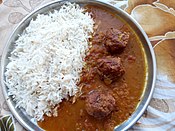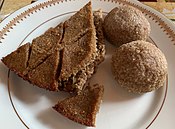코프타
Kofta
코프타(Kofta)는 발칸, 중동, 북아프리카, 남아시아, 중앙아시아 요리에서 볼 수 있는 미트볼 또는 미트로프 요리의 한 종류입니다. 가장 단순한 형태로, 코프타스는 다진 고기 공 – 보통 쇠고기, 닭고기, 돼지고기, 양고기 또는 양고기, 또는 혼합물 – 향신료와 때때로 다른 재료를 섞은 것 – 으로 구성됩니다. 알려진 가장 초기의 요리법은 초기 아랍 요리책에서 발견되며 갈은 양고기를 요구합니다.
국가적, 지역적으로 많은 차이가 있습니다. 야채와 익히지 않은 버전도 있습니다. 모양은 다양하며 볼, 패티, 실린더가 포함됩니다. 일반적으로 골프공 크기부터 오렌지 크기까지 다양합니다.
어원
영어로, kofta는 힌두어-우르두어 कोफ़्ता/کوفتہ와 페르시아어: کوفته kofta에서 차용된 외래어로, 고기를 찧었다는 의미입니다. 우르두어에서 이 단어가 사용된 것은 1665년 물라 누스라티의 ʿ ī 나마에서 처음으로 확인됩니다. 그것은 1832년에 카눈 e-이슬람에서 처음 영어로 사용되었고,[6] 그 후 1883년에 제임스 와이즈에 의해 사용되었습니다.[7] 코프타의 기원 지역의 언어들은 약간의 음운 변형이 있는 단어를 채택했습니다.[8] 비슷한 음식은 다른 언어로 크로켓, 만두, 미트볼, 리솔, 턴오버 등으로 불립니다.[8][9]
역사
코프타 요리법의 첫 등장은 가장 초기의 아랍 요리책에 있습니다.[10][8] 가장 초기의 조리법은 샤프란과 계란 노른자를 섞은 큰 갈은 양고기 미트볼을 위한 것입니다.[10] 이 글레이징 방법은 서양으로 확산되어 "길딩" 또는 "엔도어링"이라고 불립니다.[8] 코프타스는 인도로 이주했고, 앨런 데이비슨에 따르면 나르기시 코프타는 무굴 법원에서 복역했습니다.[8]
코프타는 인도 아대륙에서 중앙아시아, 중동, 발칸반도, 북아프리카를 거쳐 발견됩니다.[8] Koftas are found in the traditional cuisines of Afghanistan,[11] Albania, Bosnia and Herzegovina, Bulgaria,[8] Georgia,[12] Armenia,[11][12] Lebanon, Egypt,[11][12] Greece,[8] India,[8][11][13] Iran, Morocco,[8] Pakistan,[14] Romania,[15] Serbia, North Macedonia, and Turkey.[11][16] Engin Akin에 따르면, 튀르키예에서 그것은 "모든 종류의 공동 모임에서 선호되는 제물"입니다. 아르메니아와 아제르바이잔에서는 돌마, 라바쉬, 하리사, 케밥, 파흘라바와 함께 "분명히 상징적인 민족적 의미"가 있는 요리로, 상대국이 공동 선택한 자국의 전통 요리 중 하나라고 주장하려는 미식가들에 의해 종종 논쟁됩니다.[12] 코프타는 아시리아 사람들 사이에서 인기 있는 음식입니다.[17]
변주곡
일반적으로 고기는 향신료와 종종 밥, 불고기, 야채 또는 계란과 같은 다른 재료와 혼합되어 페이스트를 형성합니다.[8] 굽거나 튀기거나 찜하거나 수렵하거나 구우거나 재워 먹을 수 있으며, 진한 매운 소스와 함께 제공되거나 수프나 찌개에 곁들여 제공될 수 있습니다.[8] 코프타는 때때로 붉은 고기보다는 생선이나 야채, 심지어 코티지 치즈로 만들어집니다.[18] 어떤 버전은 견과류, 치즈 또는 계란으로 채워져 있습니다.[8] 일반적으로 크기는 "오렌지 크기에서 골프공 크기까지 다양하지만,[19] 일부 변형은 그 범위를 벗어납니다; 직경이 평균 20센티미터인 타브리즈 쾨프테시가 가장 큽니다.[8] 패티, 공 또는 실린더를 포함한 다양한 형태로[9] 모양을 만들 수 있습니다.[20] 일부 버전은 요리되지 않았습니다.[10]
예
- 으깬 감자에 다진 돼지고기를 섞은 루마니아식 치프테레.
- 치 ğ 쾨프테, 불구르와 때때로 날고기로 만든 터키와 아르메니아 버전.
- 보스니아, 크로아티아, 세르비아 스타일의 코프타인 추프테는 일반적으로 갈은 쇠고기 또는 갈은 양고기로 만들어지고 요리된 감자와 샐러드와 함께 제공됩니다.
- 이 ̇네골 쾨프테, 터키식 코프타.
- 이슬라마 쾨프테, 튀르키예에서 온 찐 코프타.
- 키베(Kibbeh)는 코프테(kofte)를 포함하는 중동 요리로, 때때로 날것으로 제공됩니다.
- 터키식 수프인 ı ı즐 ı.
- 카레 소스에 고기나 야채 볼을 넣은 인도 요리, Kofte Chawal. 파니어, 병박, 치킨 또는 양고기로 만든 코프타 카레와 같이 공에 사용되는 다양한 재료가 있습니다.[19]
- 쿠프테 베렌지, 쿠프테 하메다니, 쿠프테 나르, 쿠프테 타브리지, 쿠프테 시린에 케르만샤히는 모두 이란어 코프타 변종입니다.[21]
- 말라이코프타[22]
- 삶은 달걀을 코프타 혼합물에 싸서 먹는 인도 아대륙 요리, 나르기시 코프타.[8]
- 수슈루타 삼히타에서 언급된 미트볼 피쉬타.[23]
- ş터키 케밥 스타일의 코프타인 ş 쾨프테.
- 술루쾨프테, 터키 코프타 수프 또는 스튜.
- 타브리즈 쾨프테시, 평균 직경이 20cm(8인치)인 특이한 아제르바이잔 버전입니다.[8]
- 토마토를 사용하는 그리스 채식주의자 버전의 코프타인 토마토케프테데스.[24]
- Ktzitzot Khubeza - 계란 흰자와 노른자를 섞은 맬로우, 마늘, 빵 부스러기로 만든 이스라엘 코프타.
- 크림 타타르 요리의 кюфте 쿠프테(크라이마, 우크라이나).
- 이란산 타브리지 코프타에는 노란색으로 갈라진 완두콩과 감자, 다진 고기가 포함됩니다.
- 인도 출신의 코프테 차왈(병박으로 만든 채식주의자 코프타)은 밥과 함께 제공됩니다.
- 피타 속에 담긴 이집트 시가 모양의 코프타.
- 아르메니아식 코프테
참고 항목
- 미트볼 요리 목록
- 보보티
- 체바피
- 추프테
- 팔라펠
- 프리카델러
- 함박스테이크
- Kabab koobideh
- 미테이테이
- 솔즈베리 스테이크
- 스카치 에그
- 샤미케밥
- Shish taouk
- Yuvarlakia
참고문헌
- ^ "kofta". Oxford English Dictionary. 2023. Retrieved 27 December 2023.
The earliest known use of the noun kofta is in the 1880s. OED's earliest evidence for kofta is from 1888, in the writing of W. H. Dawe. kofta is a borrowing from Hindi. Etymons: Hindi kofta.
- ^ Stevenson, Angus; Waite, Maurice, eds. (18 August 2011). "kofta". Concise Oxford English Dictionary: Luxury Edition (12th ed.). Oxford University Press. p. 790. ISBN 978-0-19-960111-0.
- ^ Origin of Kofte ,Turkish köfte Arabic kufta and Hindi and Urdu koftā all from Persian kōfta (Persian kūfte) from passive participle of kōftan to pound, bray.
- ^ Nuṣratī, Mullā (1665). ʿAlī Nāma علی نامہ (in Urdu). p. 234.
Na tha har ġalūla nibolī te kam / Rakhe kofte [pl.] bār golīyāṅ te jam
- ^ Fatehpuri, Farman, ed. (June 1993) [22 vols pub. 1977–2010]. "kofta" کوفتہ. Urdu Lughat (Tareekhi Usool Par) [Urdu Dictionary on Historical Principles] (in Urdu). Vol. 15. Urdu Dictionary Board.
- ^ Shurreef, Jaffur (1832). "Appendix". Qanoon-e-Islam قانونِ اسلام [The Customs of the Moosulmans of India; Comprising a Full and Exact Account of Their Various Rites and Ceremonies, from the Moment of Birth Till the Hour of Death] (in Urdu). Translated by Herklots, Gerhard Andreas. London, England: Parbury, Allen, and Co. p. xxx. pp. xxvii, xxx:
V. Moosulman [Muslim] Cookery, (including the various Dishes alluded to in this Work). 1. Polaoos پلاؤ. ... Kofta Polaoo کوفتہ پلاؤ.
- ^ Wise, James (1883). "Nán-baí, Roṭi-wálah". Notes on the Races, Castes and Trades of Eastern Bengal. London, England: Harrison and Sons. p. 97.
[The Nān-bāʾī's] bill of fare includes a delicious, richly-flavoured curry, Kofta, or pounded meat, roasts, and puláos. ... Koftá—hashed or pounded, and fried in Ghí.
- ^ a b c d e f g h i j k l m n o p Davidson, Alan (2014). The Oxford Companion to Food. Tom Jaine, Soun Vannithone (3rd ed.). New York, NY. p. 448. ISBN 978-0-19-967733-7. OCLC 890807357.
{{cite book}}: CS1 maint: 위치 누락 게시자(링크) - ^ a b Herbst, Ron (2015). The deluxe food lover's companion. Sharon Tyler Herbst (2nd ed.). Hauppauge, New York. pp. 261–262. ISBN 978-1-4380-7621-8. OCLC 909914756.
{{cite book}}: CS1 maint: 위치 누락 게시자(링크) - ^ a b c Brown, Ellen (2020). Meatballs : the ultimate cookbook (First ed.). Kennebunkport, Maine. p. 11. ISBN 978-1-64643-014-7. OCLC 1139766078.
{{cite book}}: CS1 maint: 위치 누락 게시자(링크) - ^ a b c d e Dea, Cynthia (9 March 2015). "Where to Find the Best Meatballs in Los Angeles". KCET. Retrieved 24 August 2021.
- ^ a b c d Tsaturyan, Ruzanna (23 June 2017). "A culinary conflict in the South Caucasus". OpenDemocracy. Retrieved 24 August 2021.
- ^ Achaya, K. T. (December 1997). Indian Food Tradition A Historical Companion. Oxford University Press. p. 54. ISBN 0195644166.
- ^ Fatima, Bushra (30 June 2015). "Pakistanis' love for the succulent kofta curry". The Express Tribune. Archived from the original on 10 July 2020. Retrieved 5 July 2020.
- ^ "Chiftele Traditional Meatballs From Romania". Atlas Media. Retrieved 24 August 2021.
- ^ a b Akın, Engin (2015). Essential Turkish cuisine : 200 recipes for small plates and family meals. Helen Cathcart. New York: Stewart, Tabori & Chang, an imprint of Abrams. p. 67. ISBN 978-1-61312-871-8. OCLC 921994379.
- ^ Edelstein, Sari (2010). Food, Cuisine, and Cultural Competency for Culinary, Hospitality, and Nutrition Professionals. Jones & Bartlett Publishers. p. 594. ISBN 9781449618117.
- ^ Abdel Fattah, Iman Adel (5 December 2013). "Bites Fil Beit: Koftet el Gambari – Shrimp kofta". Daily News Egypt. Archived from the original on 3 May 2015. Retrieved 19 April 2015.
- ^ a b Fatima, Bushra (30 June 2015). "Pakistanis' love for the succulent kofta curry". The Express Tribune. Archived from the original on 10 July 2020. Retrieved 5 July 2020.
- ^ Başan, Ghillie (2021). The Turkish cookbook : exploring the food of a timeless cuisine. [London]. ISBN 978-0-7548-3515-8. OCLC 1202053063.
{{cite book}}: CS1 maint: 위치 누락 게시자(링크) - ^ "طرز تهیه کوفته و انواع آن در شهرهای ایران". Kojaro.
- ^ "Malai Kofta Recipe". Swasthi's Recipes. 27 August 2017.
- ^ Achaya, K. T. (December 1997). Indian Food Tradition A Historical Companion. Oxford University Press. p. 54. ISBN 0195644166.
- ^ 아글라이아 크렘지와 아니사 헬루, 리차드 호스킹(에드)의 '요리의 이름으로 무엇인가', 음식과 언어: Oxford Symposium on Food and Cooking 2009 (London: Prostect Books, 2010) 206













